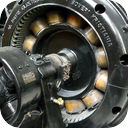(short preview of full seamless looping track)
(short preview of full seamless looping track)
(short preview of full seamless looping track)
(short preview of full seamless looping track)
(short preview of full seamless looping track)
Turbine
This product is not available in the selected currency.
In Stock
Backordered
Out of Stock
Description
The swift sound of this spinning machine makes the whole world light up and go. The cascading flow of energy enters the modern stream from city to city, sending the souls of millions of people into the sky. You sit back and relax, knowing that your handiwork has helped everyone keep up with their daily doings. So proud you are that you decide to give yourself a day off, just as soon as the boss sees that you have done as good a job tending to the turbines as you know you have. The simplest turbines have one moving part, a rotor assembly, which is a shaft or drum with blades attached. Moving fluid acts on the blades, or the blades react to the flow, so that they move and impart rotational energy to the rotor. Early turbine examples are windmills and water wheels. Credit for invention of the steam turbine is given both to the British engineer Sir Charles Parsons (1854–1931), for invention of the reaction turbine and to Swedish engineer Gustaf de Laval (1845–1913), for invention of the impulse turbine. Reaction turbines develop torque by reacting to the gas or fluid's pressure or mass. The pressure of the gas or fluid changes as it passes through the turbine rotor blades. Impulse turbines change the direction of flow of a high velocity fluid or gas jet. The resulting impulse spins the turbine and leaves the fluid flow with diminished kinetic energy. In practice, modern turbine designs use both reaction and impulse concepts to varying degrees whenever possible. Wind turbines use an airfoil to generate a reaction lift from the moving fluid and impart it to the rotor. Wind turbines also gain some energy from the impulse of the wind, by deflecting it at an angle. Crossflow turbines are designed as an impulse machine, with a nozzle, but in low head applications maintain some efficiency through reaction, like a traditional water wheel.
Opps
Sorry, it looks like some products are not available in selected quantity.



